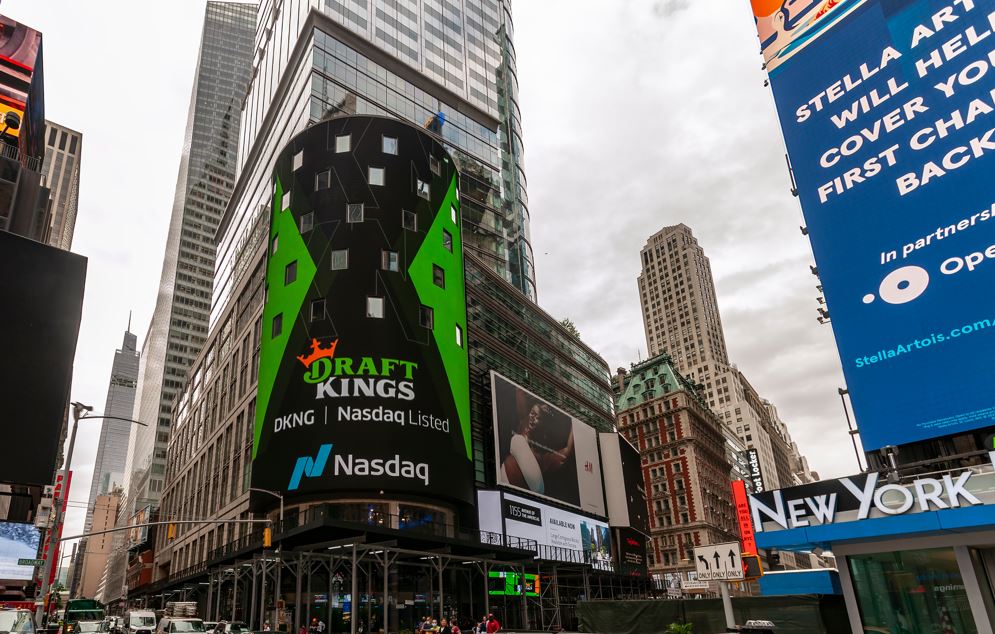DraftKings reports revenue of US$1.14 billion in third quarter

DraftKings on Thursday reported revenue of US$1.14 billion for the third quarter, an increase of US$49 million, or 4%, compared to US$1.10 billion during the same period in 2024.
DraftKings said third-quarter revenue was “driven by continued healthy customer engagement, efficient acquisition of new customers, and higher structural Sportsbook hold percentage, partially offset by customer-friendly sport outcomes.”
Earlier Thursday, DraftKings announced an agreement to become the official sportsbook and odds provider for ESPN, effective 1 December. A news release said the agreement “unites two of the most iconic brands in sports” to deliver premium sports betting content and experiences.
“This is the most bullish I have ever felt about our future,” DraftKings CEO and Co-Founder Jason Robins said in a statement. “Underlying growth in the business is accelerating, and we are excited to launch DraftKings Predictions in the coming months, which we view as a significant incremental opportunity.”
During the third quarter, monthly unique payers increased about 2% to 3.6 million average monthly unique paying customers compared to the third quarter of 2024. A news release said the increase reflects strong unique payer retention and acquisition across DraftKings’ sportsbook and igaming product offerings.
Excluding Jackpocket, MUPs increased by 6% compared to the third quarter of 2024.
Average revenue per MUP increased to US$106 in the third quarter, representing a 3% increase compared to the same period in 2024. The increase was primarily due to increased revenue in igaming as well as structural improvement in our sportsbook hold percentage, partially offset by customer-friendly sport outcomes Sportsbook.
DraftKings’ fiscal year 2025 revenue guidance has been revised. The company now expects fiscal year 2025 revenue of US$5.9 billion-US$6.1 billion. The company’s updated guidance range equates to year-over-year growth of 24% to 28% based on the company’s fiscal year 2024 revenue.
DraftKings also revised its fiscal year 2025 Adjusted EBITDA guidance to be US$450 million-US$550 million.
DraftKings stock closed at US$27.98 on the Nasdaq Thursday, up US$0.06, or 0.21%.
Verticals:
Sectors:
Topics:
Dig Deeper
The Backstory
How DraftKings arrived at this moment
DraftKings’ latest quarter lands after a year of expanding scale and recalibrating its economics. In the prior period, the company reported US$1.4 billion in fourth-quarter revenue, up 13% year over year, as monthly unique players climbed to 4.8 million. Management attributed that surge to continued engagement and the acquisition of new customers, even as “customer friendly” sports results clipped hold. The company said then it would lean harder into live betting, trim promotions and sharpen cross-sell, groundwork that set expectations heading into the current print.
Against that backdrop, DraftKings also pushed deeper into mainstream sports media distribution. The sportsbook disclosed a wide-ranging content and odds relationship with ESPN, with an effective start of Dec. 1. The tie-up aims to channel ESPN’s audience toward DraftKings’ products and analytics, a strategy that has increasingly defined how the largest U.S. operators try to convert attention into wagers. Management framed the pact as an accelerant for product discovery and retention rather than a one-off marketing splash, and it underpins the bullish tone around 2025 revenue and profitability guidance.
Investor focus has turned to whether higher structural hold and tighter promo reinvestment can offset swings in sports outcomes. That tension defined the last several quarters, when DraftKings expanded margins despite periods of bettor-friendly results. The company’s emphasis on product improvements and live betting aims to smooth volatility by deepening engagement across more in-game events, where pricing and frequency can lift effective hold over time.
Customer mix after Jackpocket
The May acquisition of Jackpocket, an online lottery app, reshaped DraftKings’ user base and per-customer revenue math. In the fourth quarter, monthly unique players rose 36% year over year to 4.8 million, but average revenue per monthly unique player fell 16% to US$97, the company said. Management noted that Jackpocket users monetize at lower levels than sportsbook and igaming customers. Excluding Jackpocket, ARPMUP declined 4% in the period, reflecting both mix and the impact of those customer-friendly sports outcomes on hold.
The current quarter’s figures continue that recalibration. DraftKings said average revenue per MUP increased in the latest period, aided by igaming and structural hold, while monthly unique payers grew at a slower rate. The company is betting that the enlarged top of the funnel will pay off through cross-sell from lottery into higher-value sportsbook and casino products. That strategy requires sustained product integration and targeted offers rather than heavy, broad-based promotions. The early read, based on stronger guidance for 2025 adjusted Ebitda, is that the company is capturing enough unit economics to justify the broader reach.
Live betting is central to that plan. As DraftKings put it after the fourth-quarter release, the operator intends to “extend its lead in live betting” and tighten the loop between its verticals. Execution will hinge on pricing accuracy, uptime and latency during peak events, areas where technology investment can translate directly into better hold and lower churn. The ESPN relationship could amplify that by surfacing betting opportunities in the moment.
Market currents in Ontario
The North American igaming landscape continues to expand, with Ontario offering a real-time case study in regulated market maturation. The province’s regulator said online gambling generated CA$3.2 billion in gross gaming revenue in its third year, with wagers of CA$82.7 billion from April 2024 to March 2025, up 31%. Casino gaming accounted for the bulk of revenue at CA$2.4 billion, up 36%, while sports betting rose 23% to CA$724 million. Poker was flat at CA$66 million. The growth underscores the appeal of igaming relative to single-event sports wagering and reinforces the industry’s push for legalization in more U.S. states.
Within that trend, Ontario set a new quarterly spending record. Players wagered CA$22.7 billion in the third quarter of fiscal 2024-25, up 32% year over year and 22% sequentially. Online casino drew CA$18.9 billion in bets, up 38%, while sports betting handle rose 10% to CA$3.4 billion. Casino revenue climbed 37% to CA$644 million, but sports betting revenue dipped 3%, reflecting the luck factor that continues to buffet operators’ quarter-to-quarter results. For companies like DraftKings, the Ontario data both validates the long-term mix shift toward igaming and highlights why diversified product sets matter when sports results break against the house.
Ontario’s regulatory changes also hint at how policy can reshape operations. The province dissolved an earlier oversight partnership in October through Bill 216, streamlining governance under iGaming Ontario. Stability and clarity on oversight remain important to the industry’s investment calculus, particularly as operators weigh marketing spend and new product launches in competitive markets.
Competitive signals from Rush Street
Rivals are broadcasting similar themes. Rush Street Interactive posted its best third quarter with US$277.9 million in revenue, up 20%, and turned a US$14.8 million profit. The operator lifted full-year guidance and pointed to accelerating growth in North American online casino markets. Monthly active users rose 34% in North America and 30% in Latin America. Management highlighted product differentiation and retention as drivers, mirroring the industry’s broader pivot away from heavy promotional spend.
On its earnings call, Rush Street amplified the case that igaming is the more durable growth engine. The company cited double-digit growth across several U.S. states and Ontario, and said Latin American revenue spurted late in the quarter, decoupled from marquee sports events. In a follow-up discussion, executives addressed geopolitical and tax issues in Colombia and Mexico and signaled discipline on new categories like prediction markets. In its third-quarter outlook commentary, Rush Street said prediction markets pose more risk to sportsbook-focused operators than to igaming-heavy companies, and argued that any tax leakage from such products could nudge more states toward legal igaming.
For DraftKings, those competitive markers matter. A rising igaming tide supports the company’s strategy to deepen casino engagement and cross-sell, especially as it integrates Jackpocket users. At the same time, Rush Street’s profitability underscores investor expectations that scaled U.S. operators can show operating leverage while still growing.
The stakes: profitability, regulation and product velocity
The near-term stakes center on delivering against 2025 revenue and adjusted Ebitda targets while keeping customer acquisition efficient. DraftKings tightened its promotional reinvestment over the past year and leaned on structural hold improvements. The ESPN integration and live betting expansion are designed to add frequency and margin without reverting to outsized bonuses. Sustained profitability will require that balance to hold as seasonal sports cycles and luck run their course.
Regulation remains the swing factor. Ontario’s growth illustrates the upside when markets open with clear rules. In the U.S., the pace of state-level igaming legalization trails sports betting. Operators argue that regulated casino online can capture spend already flowing to offshore or sweepstakes models, a point competitors like Rush Street have emphasized. Tax regimes, as seen in Latin America, can alter growth and profitability trajectories quickly, making operator agility and balance sheet flexibility important.
Finally, product velocity is emerging as a key differentiator. DraftKings has flagged new features, including a predictions product, to widen the funnel and boost engagement. Executing on faster live markets, smoother cross-vertical journeys and personalized offers will determine how much of its enlarged audience converts into higher-value customers. With peers showing momentum in igaming and regulators signaling both opportunity and risk, the company’s next phases will be judged on whether product and media distribution translate into steadier returns, not just bigger reach.






